Este guia mostra como usar Google Mobile Ads SDK para carregar e exibir anúncios da DT Exchange usando a mediação, incluindo integrações em hierarquia. Ele explica como adicionar a DT Exchange à configuração de mediação de um bloco de anúncios e como integrar o SDK e o adaptador da DT a um app Android.
Integrações e formatos de anúncio aceitos
O adaptador de mediação da DT Exchange tem os seguintes recursos:
| Integração | |
|---|---|
| Lances | 1 |
| Cascata | |
| Formatos | |
| Banner | |
| Intersticial | |
| Premiado | 2 |
| Nativo | |
1 A integração de lances está em Beta fechado. Entre em contato com seu gerente de contas para solicitar acesso.
2 O formato de anúncio premiado para lances do iOS está na versão Alfa.
Requisitos
nível da API Android 23 ou superior
[Para lances]: para integrar todos os formatos de anúncio aceitos em lances, use o adaptador da DT Exchange 8.4.0.1 ou uma versão mais recente (recomendamos usar a última versão).
Última Google Mobile Ads SDK.
Leia todo o guia para iniciantes da mediação.
Etapa 1: definir as configurações na interface da DT Exchange
Adicionar um novo app e posicionamento de anúncio
Inscreva-se ou faça login no Console da DT Exchange.
Clique em Adicionar app.

Escolha sua plataforma e seus canais, preencha o restante do formulário e clique em Criar app.

Insira os nomes e selecione os tipos das suas veiculações. Em seguida, clique em Salvar posição.
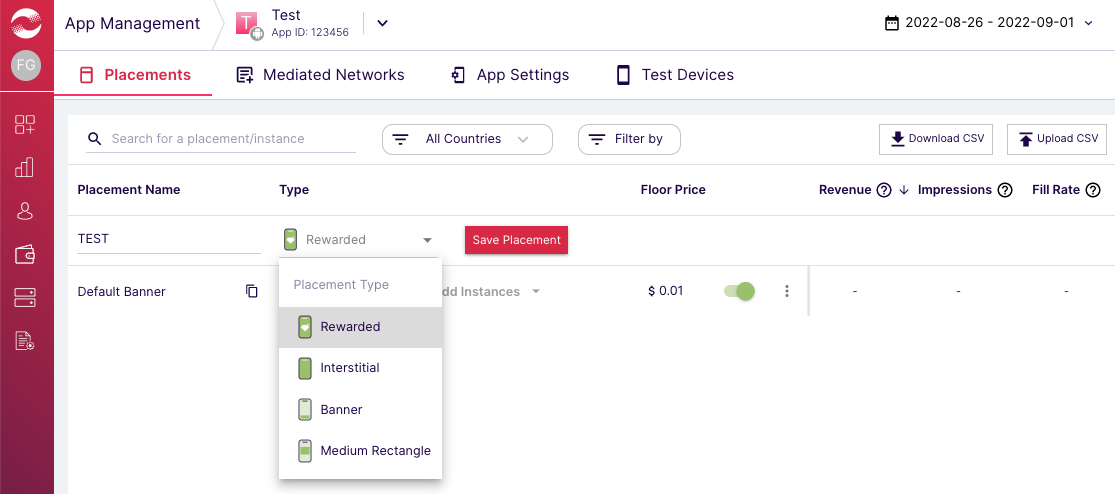
ID do app e ID da posição
Passe o cursor sobre a barra de navegação à esquerda para abrir e clique em Gerenciamento de apps.

Na página Gerenciamento de apps, anote o ID do app ao lado do seu app.
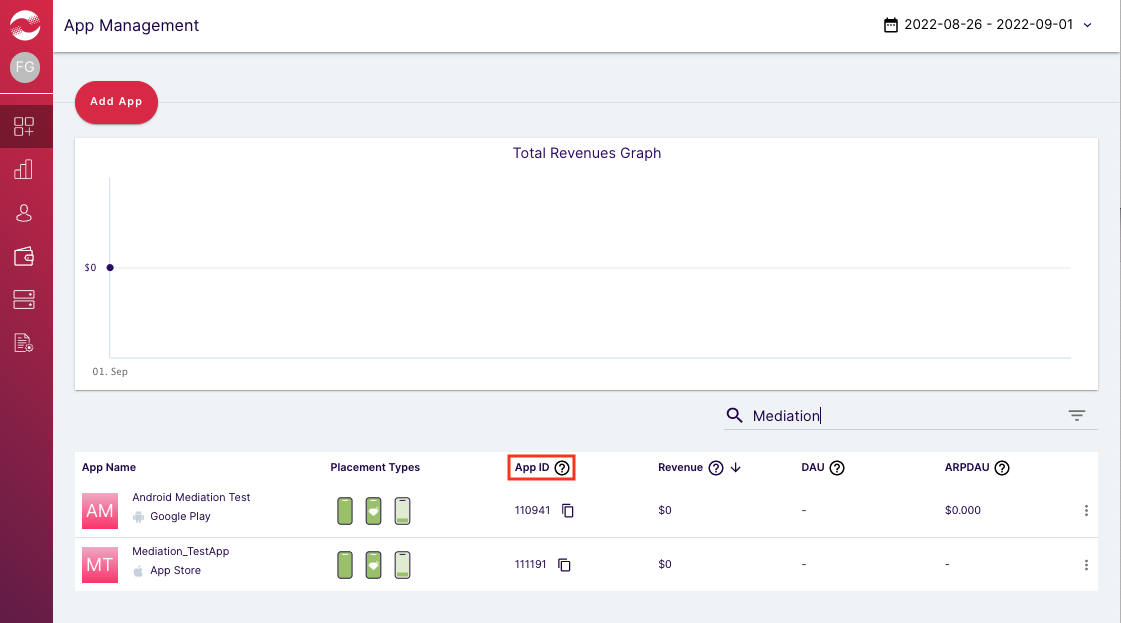
Selecione seu app e navegue até a guia Canais. Anote o ID da posição.

ID do publisher, chave do cliente e secret do consumidor
Clique no seu nome de usuário no menu à esquerda e selecione Perfil do usuário.
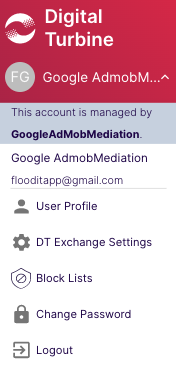
Anote o ID do publisher, o token do cliente e o segredo do cliente, porque eles serão necessários na próxima etapa.
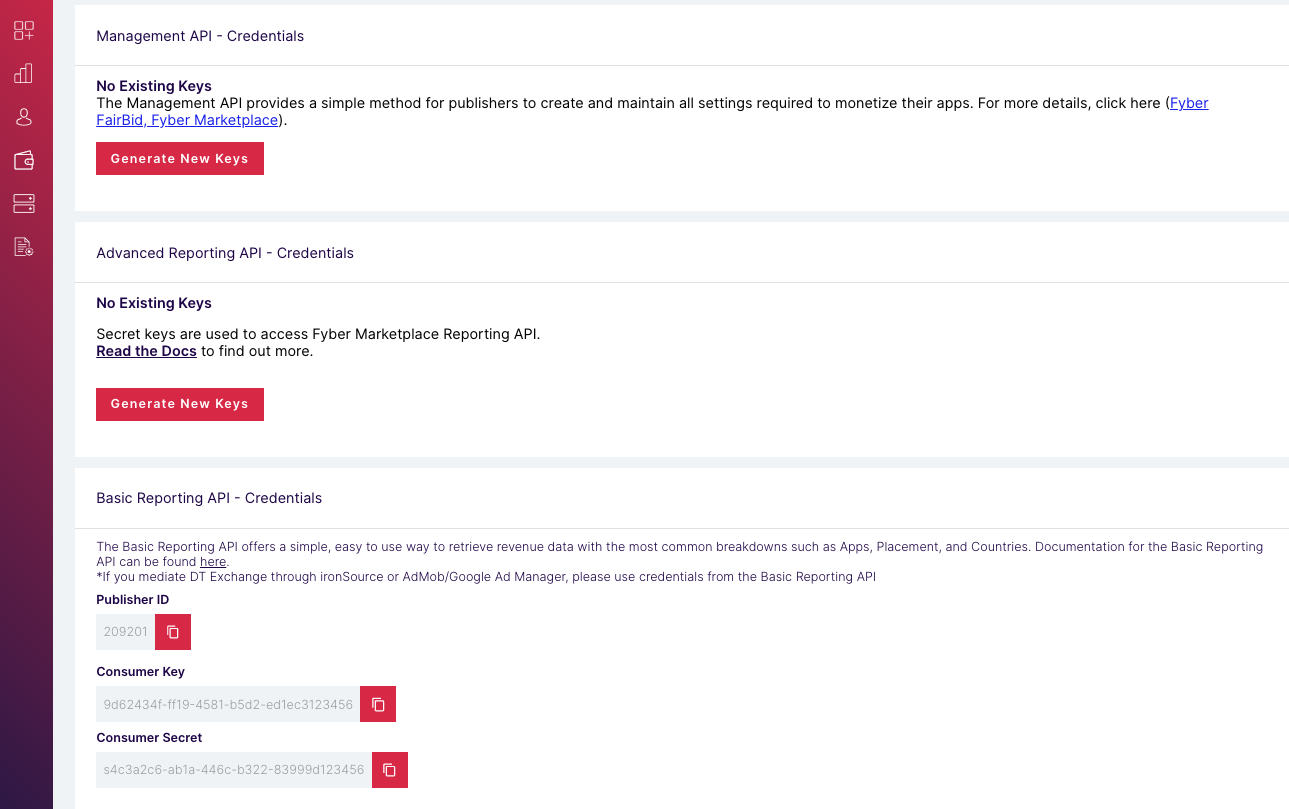
Atualizar o app-ads.txt
Vendedores autorizados do inventário de anúncios de apps (app-ads.txt) é uma iniciativa do IAB Tech Lab que ajuda a garantir que o inventário de anúncios do seu aplicativo seja vendido apenas por canais autorizados. Para evitar uma perda significativa na receita de publicidade, implemente um arquivo app-ads.txt.
Se ainda não fez isso, crie um arquivo app-ads.txt para o Ad Manager.
Para implementar o app-ads.txt na DT Exchange,
adicione a DT ao seu arquivo app-ads.txt.
Etapa 2: configurar a demanda de DT Exchange na interface do Ad Manager
Faça login na sua conta do Ad Manager.
Adicionar a DT Exchange em "Empresas"
Lances
Essa etapa não é necessária para integrações de lances.
Cascata
Acesse Administrador > Empresas e clique no botão Nova empresa na guia Todas as empresas. Selecione Rede de publicidade.

Selecione DT Exchange como a Rede de publicidade, insira um Nome exclusivo e ative a Mediação. Ative a Coleta automática de dados e insira o ID do editor, a chave secreta do consumidor e a chave do consumidor obtidos na seção anterior.
Não é necessário inserir um Nome de usuário ou uma Senha. Clique em Salvar quando terminar.
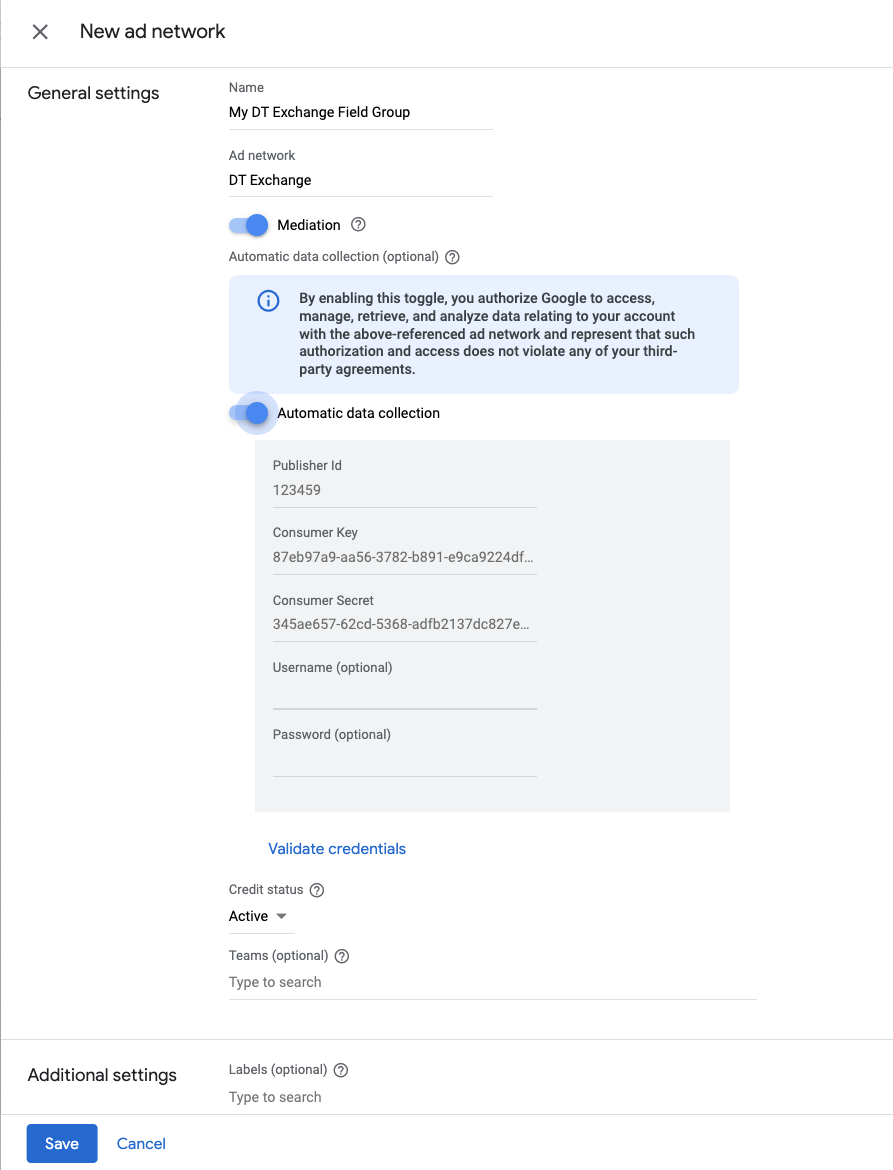
Ativar o compartilhamento de indicador seguro
Lances
Acesse Administrador > Configurações globais. Acesse a guia Configurações da conta do Ad Exchange e ative a opção Compartilhamento de indicador seguro. Clique em Salvar.

Cascata
Essa etapa não é necessária para integrações em cascata.
Compartilhar indicadores seguros em solicitações de lance
Lances
Acesse Inventário > Indicadores seguros. Em Indicadores seguros, pesquise DT Exchange (monetização da Fyber) e ative a opção Ativar integração com o app.
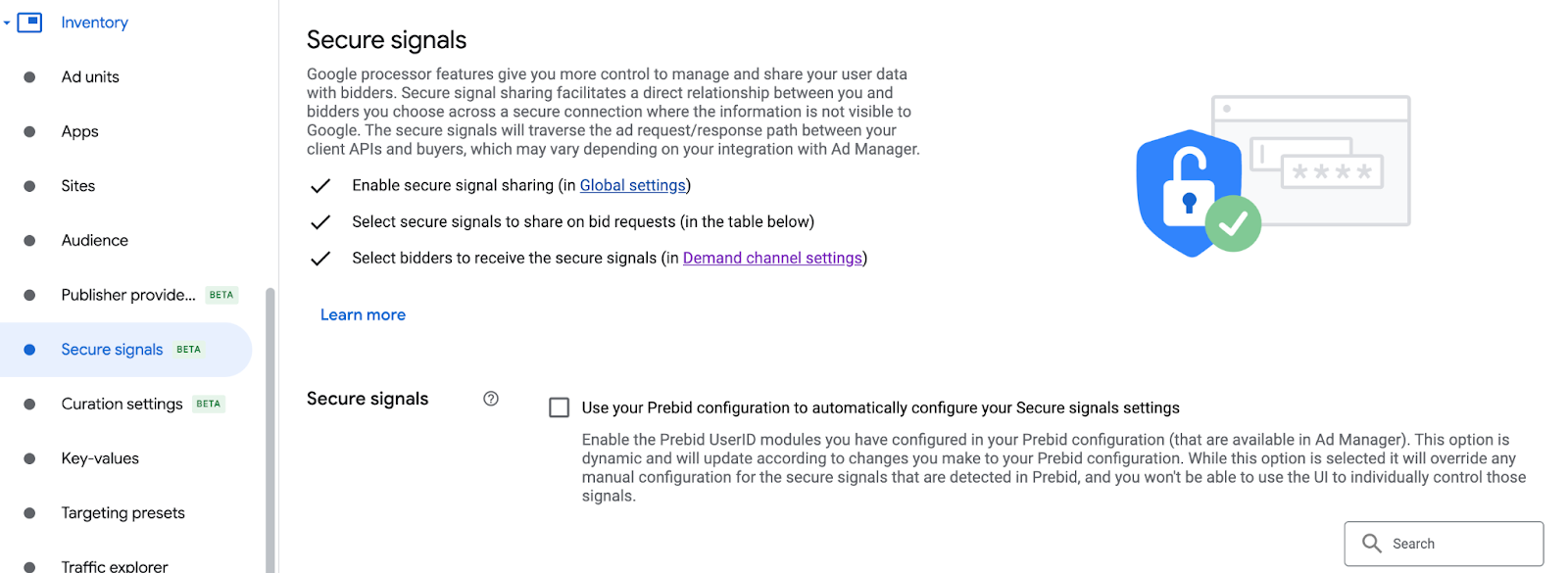
Clique em Salvar.
Cascata
Essa etapa não é necessária para integrações em cascata.
Permitir o compartilhamento de indicadores seguros para Lances do SDK
Lances
Acesse Exibição > Configurações do canal de demanda. Na guia Configurações padrão, ative a opção Permitir o compartilhamento de indicadores seguros para Lances do SDK.
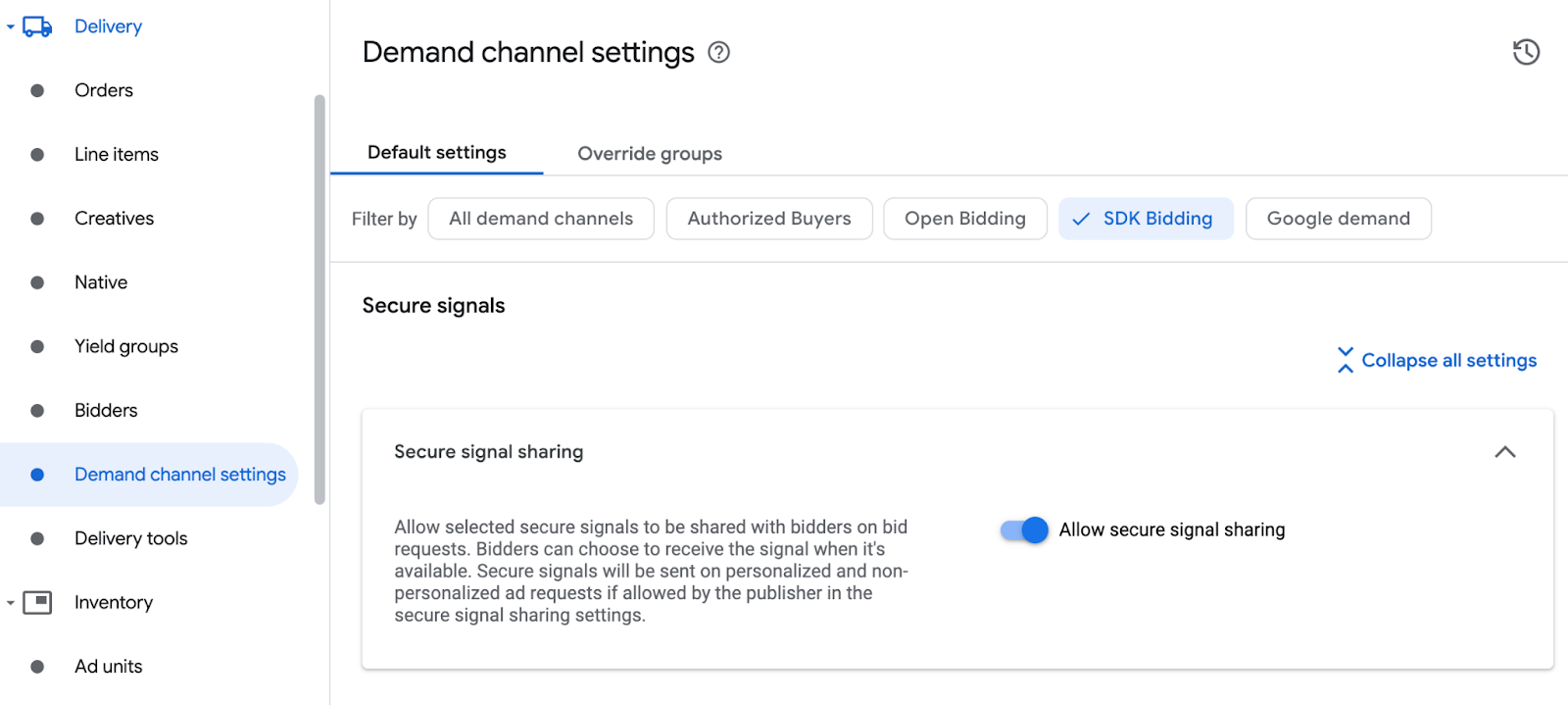
Clique em Salvar.
Cascata
Essa etapa não é necessária para integrações em cascata.
Configurar os lances da DT Exchange
Lances
Acesse Exibição > Bidders e clique em Acessar os Lances do SDK.
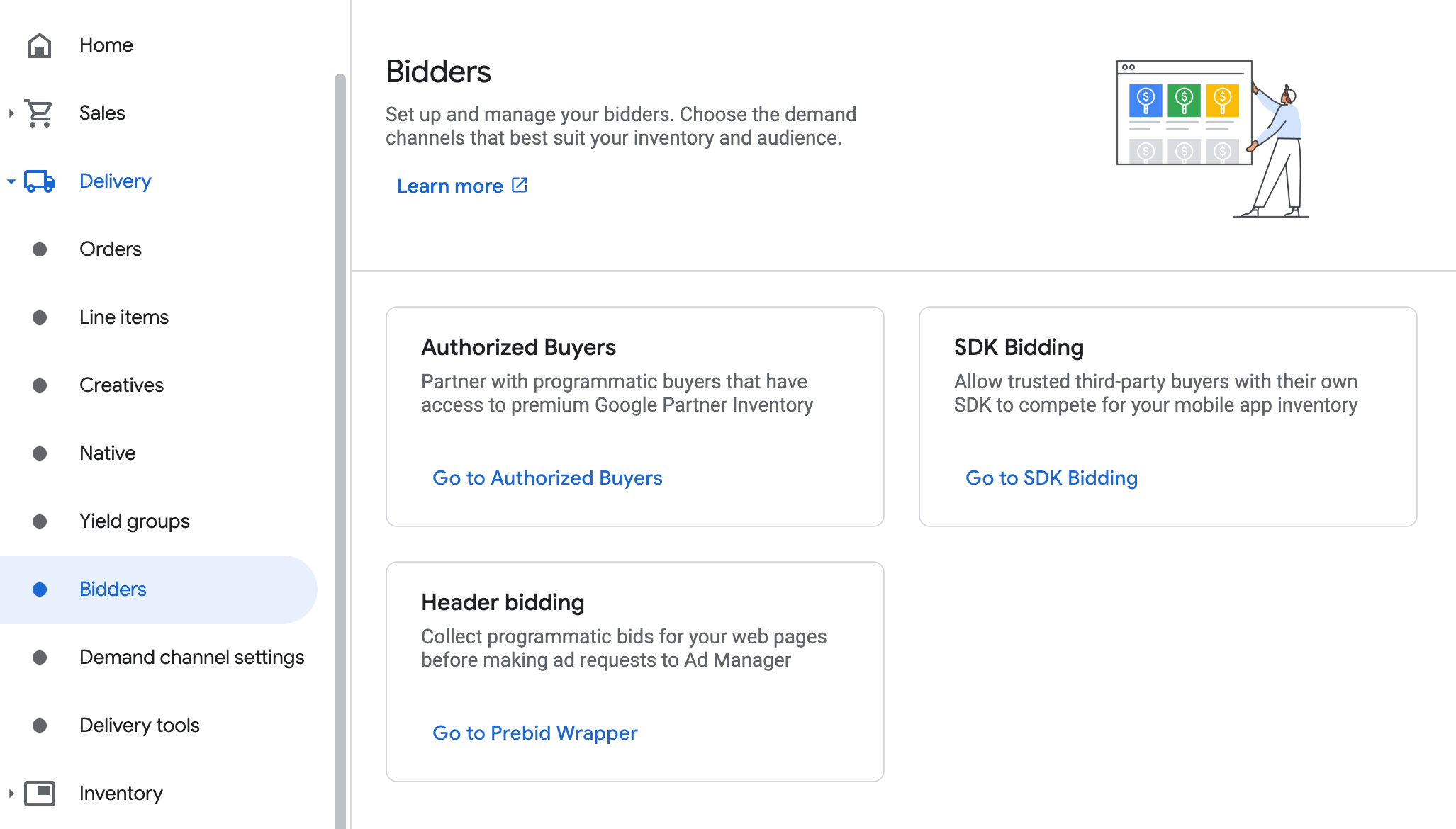
Clique em Novo bidder.
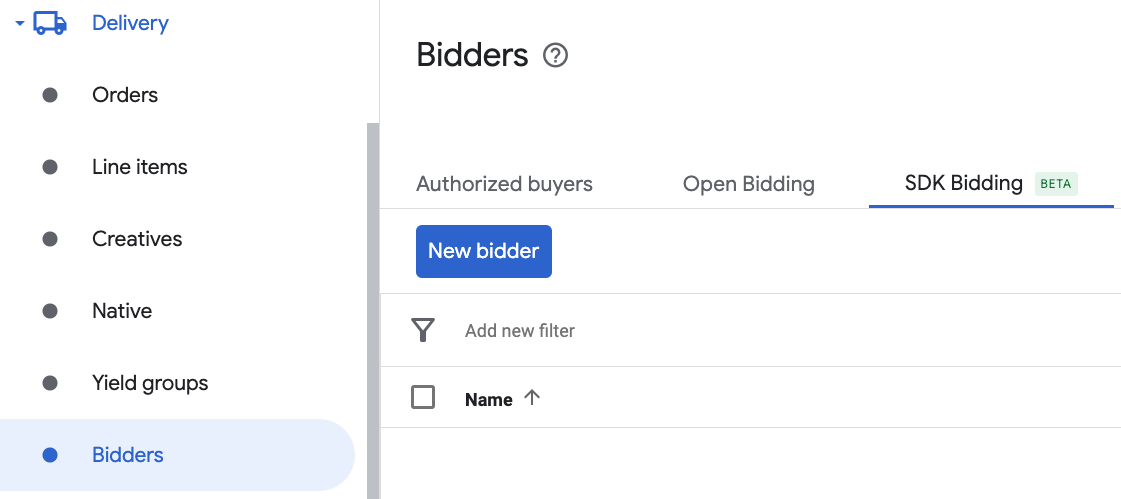
Selecione DT Exchange como o bidder.

Clique em Continuar para ativar os lances do SDK para esse bidder.

Clique em Concluído.
Cascata
Essa etapa não é necessária para integrações em cascata.
Configurar o mapeamento de blocos de anúncios
Lances
Acesse Exibição > Bidders e clique em Acessar os Lances do SDK.

Selecione a empresa para a DT Exchange.

Acesse a guia Mapeamento de bloco de anúncios e clique em Novo mapeamento de bloco de anúncios.

Escolha Bloco de anúncios específico. Selecione um bloco e um formato de anúncios, App para dispositivos móveis como o Tipo de inventário e seu Aplicativo para dispositivos móveis. Em seguida, insira o ID do aplicativo e o ID da posição obtidos na seção anterior. Por fim, clique em Salvar.

Cascata
Acesse Exibição > Grupos de rendimento e clique no botão Novo grupo de rendimento. Selecione seu Aplicativo para dispositivos móveis.

Role a tela para baixo e clique em Adicionar parceiro de rendimento.

Selecione a empresa que você criou para a DT Exchange na seção anterior. Escolha Mediação do SDK para dispositivos móveis como o Tipo de integração, Android como a Plataforma e Ativo como o Status.
Insira o ID do aplicativo e o ID da posição obtidos na seção anterior, além do valor do CPM padrão. Clique em Salvar.
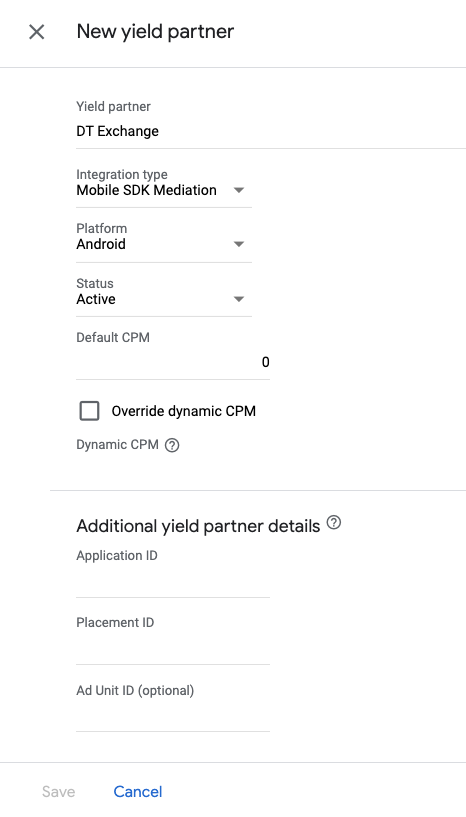
Observação: a coleta de dados automática leva alguns dias para reunir os dados antes de calcular com precisão um valor de CPM dinâmico para uma rede de mediação. Depois que o eCPM for calculado, ele será atualizado automaticamente em seu nome.
Adicionar a DT Exchange (monetização da Fyber) à lista de parceiros de publicidade do GDPR e das regulamentações estaduais dos EUA
Siga as etapas em Configurações das regulamentações europeias e Configurações das regulamentações estaduais dos EUA para adicionar a DT Exchange (monetização da Fyber) à lista de parceiros de publicidade das regulamentações europeias e estaduais dos EUA na interface do Ad Manager.
Etapa 3: importar o SDK e o adaptador da DT
Integração com o Android Studio (recomendada)
No arquivo build.gradle.kts do app, adicione as seguintes dependências e configurações de implementação. Use as versões mais recentes do SDK
e do adaptador do DT:
dependencies {
implementation("com.google.android.gms:play-services-ads:24.9.0")
implementation("com.google.ads.mediation:fyber:8.4.1.0")
}
Integração manual
- Faça o download da versão mais recente do
SDK da DT para Android e
adicione
fyber-marketplace-x.y.z.aarao seu projeto. - Navegue até os artefatos do adaptador da DT Exchange no repositório Maven do Google. Selecione a versão mais recente, faça o download do arquivo
.aardo adaptador da DT Exchange e adicione-o ao projeto.
Etapa 4: implementar configurações de privacidade no SDK da DT
Consentimento para a UE e o GDPR
Para cumprir a Política de consentimento de usuários da União Europeia do Google, você precisa fazer determinadas declarações aos seus usuários no Espaço Econômico Europeu (EEE), no Reino Unido e na Suíça, além de receber o consentimento deles para o uso de cookies ou outros armazenamentos locais quando exigido por lei e para a coleta, o compartilhamento e o uso de dados pessoais para a personalização de anúncios. Essa política reflete os requisitos da Diretiva de privacidade eletrônica da UE e do Regulamento geral de proteção de dados (GDPR). Você é responsável por verificar se o consentimento é propagado para cada origem de anúncios na sua cadeia de mediação. O Google não consegue transmitir automaticamente a escolha de consentimento do usuário para essas redes.
A partir da versão 8.3.0 do SDK da DT Exchange, a DT Exchange lê automaticamente o consentimento do GDPR definido por plataformas de gestão de consentimento que aceitam a especificação de consentimento adicional do Google. Para mais informações, consulte o guia de implementação do GDPR da DT Exchange.
Leis Estaduais de Privacidade dos EUA
As leis de privacidade dos estados dos EUA exigem que os usuários tenham o direito de recusar a "venda" das próprias "informações pessoais" (conforme a definição desses termos na lei). Essa opção é disponibilizada por um link com a mensagem "Não vender minhas informações pessoais" em destaque na página inicial do terceiro. O guia de conformidade com as leis estaduais de privacidade dos EUA oferece a opção de ativar o tratamento de dados restrito para a veiculação de anúncios do Google, mas não é possível aplicar essa configuração a cada rede de publicidade na sua cadeia de mediação. Portanto, identifique cada rede de publicidade que possa participar da venda de informações pessoais e siga as orientações de cada uma delas para garantir a conformidade.
A DT Exchange tem uma API que permite encaminhar o consentimento do usuário para o SDK dela. O exemplo de código a seguir mostra como transmitir informações de consentimento para o SDK da DT manualmente. Se você optar por transmitir informações de consentimento para o SDK do DT manualmente, recomendamos que esse código seja chamado antes de solicitar anúncios por Google Mobile Ads SDK.
Java
Kotlin
Substitua US_PRIVACY_STRING pela sua string de privacidade dos EUA.
Acesse o guia de implementação da CCPA da DT Exchange para mais detalhes e os valores que podem ser fornecidos no método.
Etapa 5: adicionar o código necessário
Carregar o anúncio com o contexto da atividade
Transmita o contexto Activity ao carregar formatos de anúncio intersticial. Sem informações sobre a atividade, haverá falha no carregamento.
Etapa 6: testar a implementação
Ativar anúncios de teste
Registre seu dispositivo de teste no Ad Manager.
Verificar anúncios de teste
Para verificar se você está recebendo anúncios de teste da DT Exchange, ative o teste de uma única origem de anúncios no Ad Inspector usando as origens de anúncios DT Exchange (lances) e DT Exchange (hierarquia).
Etapas opcionais
Parâmetros específicos da rede
O adaptador da DT Exchange é compatível com outros parâmetros de solicitação que podem ser transmitidos ao adaptador como um pacote do Android. O adaptador procura as seguintes chaves no pacote:
| Parâmetros e valores de solicitação | |
|---|---|
InneractiveMediationDefs.KEY_AGE
|
Número inteiro. A idade do usuário |
FyberMediationAdapter.KEY_MUTE_VIDEO
|
Boolean. Ativar ou desativar o som do vídeo |
Confira um exemplo de código de como definir esses parâmetros de solicitação de anúncio:
Java
Bundle extras = new Bundle();
extras.putInt(InneractiveMediationDefs.KEY_AGE, 10);
extras.putBoolean(FyberMediationAdapter.KEY_MUTE_VIDEO, false);
AdRequest request =
new AdRequest.Builder().addNetworkExtrasBundle(FyberMediationAdapter.class, extras).build();
Kotlin
val extras = Bundle()
extras.putInt(InneractiveMediationDefs.KEY_AGE, 10)
extras.putBoolean(FyberMediationAdapter.KEY_MUTE_VIDEO, false)
val request =
AdRequest.Builder().addNetworkExtrasBundle(FyberMediationAdapter::class.java, extras).build()
Códigos de erro
Se o adaptador não receber um anúncio da DT Exchange, verifique o erro subjacente na resposta do anúncio usando ResponseInfo.getAdapterResponses() na seguinte classe:
com.google.ads.mediation.fyber.FyberMediationAdapter
Confira os códigos e as mensagens correspondentes gerados pelo adaptador da DT Exchange quando um anúncio não é carregado:
| Código do erro | Motivo |
|---|---|
| 101 | Os parâmetros do servidor da DT Exchange configurados na interface do Ad Manager estão ausentes ou são inválidos. |
| 103 | O tamanho de anúncio solicitado não corresponde a um tamanho de banner compatível com a DT Exchange. |
| 105 | O SDK da DT carregou um anúncio, mas retornou um controlador inesperado. |
| 106 | O anúncio não está pronto para ser exibido. |
| 107 | O contexto não é uma instância de atividade. |
| 200 a 399 | O SDK da DT retornou um erro. Consulte o código para mais detalhes. |
Registro de alterações do adaptador de mediação do Android da DT Exchange
Versão 8.4.1.0
- Compatibilidade verificada com o SDK da DT Exchange 8.4.1.
Criado e testado com:
- Versão 24.8.0 do SDK dos anúncios para dispositivos móveis do Google.
- Versão 8.4.1 do SDK da DT Exchange.
Versão 8.4.0.1
- Adição de suporte para anúncios nativos
- Compatibilidade verificada com o SDK da DT Exchange 8.4.0.
Criado e testado com:
- Versão 24.7.0 do SDK dos anúncios para dispositivos móveis do Google.
- Versão 8.4.0 do SDK da DT Exchange.
Versão 8.4.0.0
- Referências no nível da classe ao contexto removidas. Pode ajudar a reduzir problemas de vazamento de memória.
- Compatibilidade verificada com o SDK da DT Exchange 8.4.0.
Criado e testado com:
- Versão 24.6.0 do SDK dos anúncios para dispositivos móveis do Google.
- Versão 8.4.0 do SDK da DT Exchange.
Versão 8.3.8.0
- Refatoração dos códigos de erro em um novo arquivo DTExchangeErrorCodes.kt.
- Compatibilidade verificada com o SDK da DT Exchange 8.3.8.
Criado e testado com:
- Versão 24.5.0 do SDK dos anúncios para dispositivos móveis do Google.
- Versão 8.3.8 do SDK da DT Exchange.
Versão 8.3.7.0
- Atualizamos o adaptador para oferecer suporte a lances para formatos de anúncio de banner, intersticial e premiado.
- Compatibilidade verificada com o SDK da DT Exchange 8.3.7.
Criado e testado com:
- Versão 24.1.0 do SDK dos anúncios para dispositivos móveis do Google.
- Versão 8.3.7 do SDK da DT Exchange.
Versão 8.3.6.1
- Atualizamos o nível mínimo necessário da API Android para 23.
- Atualizamos a versão mínima necessária do SDK dos anúncios para dispositivos móveis do Google para 24.0.0.
Criado e testado com:
- Versão 24.0.0 do SDK dos anúncios para dispositivos móveis do Google.
- Versão 8.3.6 do SDK da DT Exchange.
Versão 8.3.6.0
- Compatibilidade verificada com o SDK da DT Exchange 8.3.6.
Criado e testado com:
- Versão 23.6.0 do SDK dos anúncios para dispositivos móveis do Google.
- Versão 8.3.6 do SDK da DT Exchange.
Versão 8.3.5.0
- Compatibilidade verificada com o SDK da DT Exchange 8.3.5.
Criado e testado com:
- Versão 23.6.0 do SDK dos anúncios para dispositivos móveis do Google.
- Versão 8.3.5 do SDK da DT Exchange.
Versão 8.3.4.0
- Compatibilidade verificada com o SDK 8.3.4 da DT Exchange.
Criado e testado com:
- Versão 23.6.0 do SDK dos anúncios para dispositivos móveis do Google.
- Versão 8.3.4 do SDK da DT Exchange.
Versão 8.3.3.0
- Compatibilidade verificada com o SDK 8.3.3 da DT Exchange.
Criado e testado com:
- Versão 23.5.0 do SDK dos anúncios para dispositivos móveis do Google.
- Versão 8.3.3 do SDK da DT Exchange.
Versão 8.3.2.0
- Compatibilidade verificada com o SDK da DT Exchange 8.3.2.
Criado e testado com:
- Versão 23.4.0 do SDK dos anúncios para dispositivos móveis do Google.
- Versão 8.3.2 do SDK da DT Exchange.
Versão 8.3.1.0
- Compatibilidade verificada com o SDK 8.3.1 da DT Exchange.
Criado e testado com:
- Versão 23.3.0 do SDK dos anúncios para dispositivos móveis do Google.
- Versão 8.3.1 do SDK da DT Exchange.
Versão 8.3.0.0
- Adicionada compatibilidade para transmitir a versão do SDK dos anúncios para dispositivos móveis do Google ao SDK da DT Exchange.
- Compatibilidade verificada com o SDK da DT Exchange 8.3.0.
Criado e testado com:
- Versão 23.2.0 do SDK dos anúncios para dispositivos móveis do Google.
- Versão 8.3.0 do SDK da DT Exchange.
Versão 8.2.7.0
- Compatibilidade verificada com o SDK 8.2.7 da DT Exchange.
Criado e testado com:
- Versão 23.0.0 do SDK dos anúncios para dispositivos móveis do Google.
- Versão 8.2.7 do SDK da DT Exchange.
Versão 8.2.6.1
- Atualizamos a versão mínima necessária do SDK dos anúncios para dispositivos móveis do Google para 23.0.0.
- Compatibilidade verificada com o SDK da DT Exchange 8.2.6.
Criado e testado com:
- Versão 23.0.0 do SDK dos anúncios para dispositivos móveis do Google.
- Versão 8.2.6 do SDK da DT Exchange.
Versão 8.2.6.0
- Compatibilidade verificada com o SDK da DT Exchange 8.2.6.
Criado e testado com:
- Versão 22.6.0 do SDK dos anúncios para dispositivos móveis do Google.
- Versão 8.2.6 do SDK da DT Exchange.
Versão 8.2.5.0
- Compatibilidade verificada com o SDK da DT Exchange 8.2.5.
Criado e testado com:
- Versão 22.5.0 do SDK dos anúncios para dispositivos móveis do Google.
- Versão 8.2.5 do SDK da DT Exchange.
Versão 8.2.4.0
- Compatibilidade verificada com o SDK da DT Exchange 8.2.4.
Criado e testado com:
- Versão 22.3.0 do SDK dos anúncios para dispositivos móveis do Google.
- Versão 8.2.4 do SDK da DT Exchange.
Versão 8.2.3.0
- Adaptador atualizado para usar a nova classe
VersionInfo. - Atualizamos a versão mínima necessária do SDK dos anúncios para dispositivos móveis do Google para 22.0.0.
Criado e testado com:
- Versão 22.0.0 do SDK dos anúncios para dispositivos móveis do Google.
- Versão 8.2.3 do SDK da DT Exchange.
Versão 8.2.2.1
- Adicionamos suporte para transmitir a chave
muteVideono extra de mediação para desativar anúncios intersticiais.
Criado e testado com:
- Versão 21.5.0 do SDK dos anúncios para dispositivos móveis do Google.
- Versão 8.2.2 do SDK da DT Exchange.
Versão 8.2.2.0
- Compatibilidade verificada com o SDK 8.2.2 da DT Exchange.
- Atualizamos a versão mínima necessária do SDK dos anúncios para dispositivos móveis do Google para 21.5.0.
Criado e testado com:
- Versão 21.5.0 do SDK dos anúncios para dispositivos móveis do Google.
- Versão 8.2.2 do SDK da DT Exchange.
Versão 8.2.1.0
- Mudança do nome do adaptador para "DT Exchange".
- Compatibilidade verificada com o SDK da DT Exchange 8.2.1.
- Atualizamos a versão mínima necessária do SDK dos anúncios para dispositivos móveis do Google para 21.3.0.
Criado e testado com:
- Versão 21.3.0 do SDK dos anúncios para dispositivos móveis do Google.
- Versão 8.2.1 do SDK da DT Exchange.
Versão 8.2.0.0
- Compatibilidade verificada com o SDK da Fyber 8.2.0.
- Atualizamos a versão mínima necessária do SDK dos anúncios para dispositivos móveis do Google para 21.1.0.
Criado e testado com:
- Versão 21.1.0 do SDK dos anúncios para dispositivos móveis do Google.
- Versão 8.2.0 do SDK da Fyber.
Versão 8.1.5.0
- Compatibilidade verificada com o SDK da Fyber 8.1.5.
Criado e testado com:
- Versão 21.0.0 do SDK dos anúncios para dispositivos móveis do Google.
- Versão 8.1.5 do SDK da Fyber.
Versão 8.1.4.0
- Compatibilidade verificada com o SDK da Fyber 8.1.4.
Criado e testado com:
- Versão 21.0.0 do SDK dos anúncios para dispositivos móveis do Google.
- Versão 8.1.4 do SDK da Fyber.
Versão 8.1.3.1
compileSdkVersionetargetSdkVersionforam atualizados para a API 31.- Atualizamos a versão mínima necessária do SDK dos anúncios para dispositivos móveis do Google para 21.0.0.
- Atualizamos o nível mínimo necessário da API Android para 19.
Criado e testado com:
- Versão 21.0.0 do SDK dos anúncios para dispositivos móveis do Google.
- Versão 8.1.3 do SDK da Fyber.
Versão 8.1.3.0
- Compatibilidade verificada com o SDK da Fyber 8.1.3.
- Atualizamos a versão mínima necessária do SDK dos anúncios para dispositivos móveis do Google para 20.6.0.
Criado e testado com:
- Versão 20.6.0 do SDK dos anúncios para dispositivos móveis do Google.
- Versão 8.1.3 do SDK da Fyber.
Versão 8.1.2.0
- Compatibilidade verificada com o SDK da Fyber 8.1.2.
- Atualizamos a versão mínima necessária do SDK dos anúncios para dispositivos móveis do Google para 20.5.0.
Criado e testado com:
- Versão 20.5.0 do SDK dos anúncios para dispositivos móveis do Google.
- Versão 8.1.2 do SDK da Fyber.
Versão 8.1.0.0
- Compatibilidade verificada com o SDK da Fyber 8.1.0.
Criado e testado com:
- Versão 20.4.0 do SDK dos anúncios para dispositivos móveis do Google.
- Versão 8.1.0 do SDK da Fyber.
Versão 7.8.4.1
- Foi corrigido um problema em que o adaptador não era inicializado se houvesse um ID de app duplicado ou mais de um ID de app exclusivo nas configurações de mediação.
- Atualizamos a versão mínima necessária do SDK dos anúncios para dispositivos móveis do Google para 20.4.0.
Criado e testado com:
- Versão 20.4.0 do SDK dos anúncios para dispositivos móveis do Google.
- Versão 7.8.4 do SDK da Fyber.
Versão 7.8.4.0
- Compatibilidade verificada com o SDK da Fyber 7.8.4.
- Atualizamos a versão mínima necessária do SDK dos anúncios para dispositivos móveis do Google para 20.3.0.
- Correção de um problema com anúncios de display premiados, em que
onVideoComplete()não era chamado. - Agora, a Fyber exige um contexto de atividade para mostrar anúncios.
Criado e testado com:
- Versão 20.3.0 do SDK dos anúncios para dispositivos móveis do Google.
- Versão 7.8.4 do SDK da Fyber.
Versão 7.8.3.0
- Compatibilidade verificada com o SDK da Fyber 7.8.3.
- Adicionamos códigos e mensagens de erro padronizados do adaptador.
- Atualizamos a versão mínima necessária do SDK dos anúncios para dispositivos móveis do Google para 20.1.0.
Criado e testado com:
- Versão 20.1.0 do SDK dos anúncios para dispositivos móveis do Google.
- Versão 7.8.3 do SDK da Fyber.
Versão 7.8.2.0
- Compatibilidade verificada com o SDK da Fyber 7.8.2.
- Atualizamos a versão mínima necessária do SDK dos anúncios para dispositivos móveis do Google para 20.0.0.
Criado e testado com:
- Versão 20.0.0 do SDK dos anúncios para dispositivos móveis do Google.
- Versão 7.8.2 do SDK da Fyber.
Versão 7.8.1.0
- Compatibilidade verificada com o SDK da Fyber 7.8.1.
Criado e testado com:
- Versão 19.7.0 do SDK dos anúncios para dispositivos móveis do Google.
- Versão 7.8.1 do SDK da Fyber.
Versão 7.8.0.0
- Compatibilidade verificada com o SDK da Fyber 7.8.0.
- Atualizamos a versão mínima necessária do SDK dos anúncios para dispositivos móveis do Google para 19.7.0.
Criado e testado com:
- Versão 19.7.0 do SDK dos anúncios para dispositivos móveis do Google.
- Versão 7.8.0 do SDK da Fyber.
Versão 7.7.4.0
- Compatibilidade verificada com o SDK da Fyber 7.7.4.
- Correção de um problema em que
onUserEarnedReward()era encaminhado duas vezes para anúncios premiados.
Criado e testado com:
- Versão 19.5.0 do SDK dos anúncios para dispositivos móveis do Google.
- Versão 7.7.4 do SDK da Fyber.
Versão 7.7.3.0
- Compatibilidade verificada com o SDK da Fyber 7.7.3.
Criado e testado com:
- Versão 19.5.0 do SDK dos anúncios para dispositivos móveis do Google.
- Versão 7.7.3 do SDK da Fyber.
Versão 7.7.2.0
- Compatibilidade verificada com o SDK da Fyber 7.7.2.
- Atualizamos a versão mínima necessária do SDK dos anúncios para dispositivos móveis do Google para 19.5.0.
Criado e testado com:
- Versão 19.5.0 do SDK dos anúncios para dispositivos móveis do Google.
- Versão 7.7.2 do SDK da Fyber.
Versão 7.7.1.0
- Compatibilidade verificada com o SDK da Fyber 7.7.1.
- Atualizamos a versão mínima necessária do SDK dos anúncios para dispositivos móveis do Google para 19.4.0.
Criado e testado com:
- Versão 19.4.0 do SDK dos anúncios para dispositivos móveis do Google.
- Versão 7.7.1 do SDK da Fyber.
Versão 7.7.0.0
- Compatibilidade verificada com o SDK da Fyber 7.7.0.
Criado e testado com:
- Versão 19.3.0 do SDK dos anúncios para dispositivos móveis do Google.
- Versão 7.7.0 do SDK da Fyber.
Versão 7.6.1.0
- Compatibilidade verificada com o SDK da Fyber 7.6.1.
Criado e testado com:
- Versão 19.3.0 do SDK dos anúncios para dispositivos móveis do Google.
- Versão 7.6.1 do SDK da Fyber.
Versão 7.6.0.0
- Compatibilidade verificada com o SDK da Fyber 7.6.0.
- Atualizamos o adaptador para oferecer suporte a solicitações de banners adaptativos in-line.
- Atualizamos a versão mínima necessária do SDK dos anúncios para dispositivos móveis do Google para 19.3.0.
- Correção de um bug em que os métodos onAdOpened()/onAdClosed() não eram chamados para anúncios de banner.
Criado e testado com:
- Versão 19.3.0 do SDK dos anúncios para dispositivos móveis do Google.
- Versão 7.6.0 do SDK da Fyber.
Versão 7.5.4.0
- Compatibilidade verificada com o SDK da Fyber 7.5.4.
- Atualizamos a versão mínima necessária do SDK dos anúncios para dispositivos móveis do Google para 19.1.0.
Criado e testado com:
- Versão 19.1.0 do SDK dos anúncios para dispositivos móveis do Google.
- Versão 7.5.4 do SDK da Fyber.
Versão 7.5.3.0
- Compatibilidade verificada com o SDK da Fyber 7.5.3.
Criado e testado com:
- Versão 19.0.1 do SDK dos anúncios para dispositivos móveis do Google.
- Versão 7.5.3 do SDK da Fyber.
Versão 7.5.2.0
- Compatibilidade verificada com o SDK da Fyber 7.5.2.
- Atualizamos a versão mínima necessária do SDK dos anúncios para dispositivos móveis do Google para 19.0.1.
Criado e testado com:
- Versão 19.0.1 do SDK dos anúncios para dispositivos móveis do Google.
- Versão 7.5.2 do SDK da Fyber.
Versão 7.5.0.0
- Compatibilidade verificada com o SDK da Fyber 7.5.0.
- Correção de uma falha de NullPointerException durante o carregamento de anúncios da Fyber.
Criado e testado com:
- Versão 18.3.0 do SDK dos anúncios para dispositivos móveis do Google.
- Versão 7.5.0 do SDK da Fyber.
Versão 7.4.1.0
- Compatibilidade verificada com o SDK da Fyber 7.4.1.
- Atualizamos a versão mínima necessária do SDK dos anúncios para dispositivos móveis do Google para 18.3.0.
Criado e testado com:
- Versão 18.3.0 do SDK dos anúncios para dispositivos móveis do Google.
- Versão 7.4.1 do SDK da Fyber.
Versão 7.3.4.0
- Versão inicial.
- Suporta anúncios de banner, intersticiais e premiados.
Criado e testado com:
- Versão 18.2.0 do SDK dos anúncios para dispositivos móveis do Google.
- Versão 7.3.4 do SDK da Fyber.


